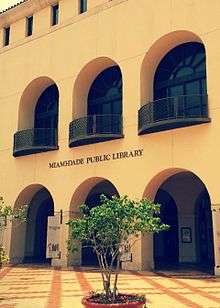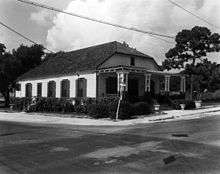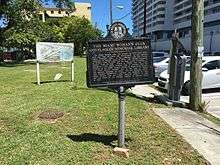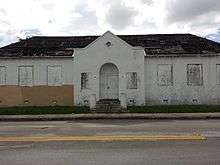Miami-Dade Public Library System
|
Main Library, Downtown Miami | |
| Country | United States |
|---|---|
| Type | Public |
| Established | 1966 |
| Location | 101 W Flagler St, Miami, FL 33130 |
| Branches | 49 + 2 bookmobiles |
| Collection | |
| Size | 3,916,631 |
| Access and use | |
| Access requirements | 1,084,841 |
| Circulation | 6,762,294 |
| Population served | 2,496,435 |
| Other information | |
| Director | Gia Arbogast |
| Website | |
The Miami-Dade Public Library System (MDPLS) is a system of libraries in Miami-Dade County, Florida in the United States.

Governance
MDPLS is a County Department within Miami-Dade County Government that reports to the Mayor of Miami-Dade County. The Miami-Dade Board of County Commissioners is the Governing Body over MDPLS.
The Library Advisory Board (Sect. 2-192 Code of Miami-Dade County) serves in an advisory capacity to the Board of County Commissioners on public library issues, providing reports, recommendations, and guidance to the Board of County Commissioners. The full scope of the Library Advisory Board's duties can be reviewed at the link provided.
Service Area
The service area of MDPLS is defined by the Miami-Dade Library Taxing District. The Miami-Dade Library Taxing District includes the majority of the geographical boundaries of Miami-Dade County, including most of its 35 municipalities and all of Unincorporated Miami-Dade County. Exceptions include the Cities of Hialeah , North Miami , North Miami Beach , and Miami Shores , all of which provide library service directly to their respective residents. Additionally, the Cities of Bal Harbour and Surfside are not part of the Miami-Dade Library Taxing District.
History
Early years
The Miami-Dade Public Library System traces its origin to the late nineteenth century. The first library was a reading room established in Lemon City on April 7, 1894 by the Lemon City Library and Improvement Association. Miss Ada Merritt had already started a library in the public school in Lemon City in 1893, but the modest Lemon City Library, which was originally located in the front room of Mrs. Cornelia Keyes' Cottage, was opened to serve all of the 350 Lemon City residents.[1][2][3] In 1902 the Lemon City Library moved into its own building made of wood planks located at 412 NE 61st Street.[4][5]

The Cocoanut Grove (original spelling) library opened on June 15, 1895 by the ladies of the Pine Needles Club.[6] Mrs. Andrew Carnegie helped with the beginning of the library with the contribution of bundles of books.[7] In 1900 the Cocoanut Grove Library Association was incorporated and in 1901 Miami-Dade County's first library building was built in Cocoanut Grove.[8][9]
The City of Miami's library was founded by the Ladies' Afternoon Club, later the Miami Women's Club. Its purpose was "reading and the discussion of literature." By 1905, the Club was trying to provide a public reading room for its collection of books. The Club had no permanent home and for a number of years the reading room moved from place to place, as often as six times in a single year. By 1913 the Miami Women's Club had its own building located at the corner of today's Southeast Second Avenue and Flagler Street (then Avenue B and Twelfth Street) on property donated by Henry Morrison Flagler. His gift of land for the construction of a clubhouse contained a proviso that a public reading room be maintained in the building. Reliable financial support for the library was a continuing problem and in 1915 the Miami City Commission was convinced to support the library and $50 each month was allocated to its support. This downtown location was later sold and the Miami Women's Club erected its current building at 1737 North Bayshore Drive. The Flagler Memorial Library was established in this new building.

By 1925 the communities of Coconut Grove and Lemon City had been annexed into the City of Miami.
Bookmobiles
The first bookmobile was proudly pictured in the Miami Herald of January 5, 1928 (Miami Herald - Flashback Miami).
The first public library serving the Black community was the Dunbar Branch at 2059 N. W. 6 Court, established March 14, 1938 by the Friendship Garden Club, assisted by the Miami Woman's Club.
Annie M. Coleman and the Dunbar Library
When Annie M. Coleman (1894-1981), and her husband, Reverend James E. Coleman, moved to Miami in 1922 from Quitman, Georgia, "Colored Town" (known as Overtown today) had no paved streets, no parks and no library. Mrs. Coleman's vision and initiative made her a pioneer in obtaining these much-needed facilities.[10]
Mrs. Coleman, a graduate of Paine College, had been in Miami only one year when she organized the Women's Club, which later became the Murrell Branch of the YMCA. She also founded the local chapter of the National Council of Negro Women and served for 25 years as president of Miami's Friendship Garden and Civic Club. She worked with other women activists, such as Mary Sorensen Moore, and Mary Jane Wood Reeder, to increase opportunities for black people in the then segregated society.[11] She was also in the forefront of the movement to allow blacks to serve as policemen in Miami. She pushed for the paving of neighborhood streets and raised funds for Christian Hospital.[11]
It was in this climate that the first library for African-Americans was created. In 1936, the Women's Society of Christian Services, an organization within the Trinity Methodist Episcopal Church joined with other civic-minded women in the Black community to found the Friendship Garden and Civic Club. Led by its president, Annie Coleman, the club's first project was to create a library for the residents of Overtown. Mrs. Coleman offered the use of a grocery store building next to her home. That building, at 2059 NW 6th Court, was converted into a library largely through the combined efforts of the Overtown African-American community. That first library opened in 1936 and was called the Paul Laurence Dunbar Library.[12] It provided books, a Black History week celebration, and other educational material for children.
In 1938, the facility became the Dunbar Branch Library, as it was now officially a part of the City of Miami's library system. The needs of the community would soon make that library obsolete, setting the stage for the construction of the Dorsey Memorial Library.[12]
While the Dunbar Branch was being used, the Friendship Garden Club and the Washington Heights Library Association raised funds to build a new library. The City of Miami appropriated the remainder of the money to build on land donated by Black philanthropist Dana A. Dorsey. The one-story concrete block and stucco building was named the Dorsey Memorial Library and opened on August 13, 1941, under the supervision of the Miami Public Library's Head Librarian. This was the first public library building owned by the City of Miami.

The City of Miami thus had several community libraries receiving various amounts of financial support from public funds.
Unification
In 1942 these libraries were brought together in a single public library system, governed by a Board of Trustees and administered by a Head Librarian, with administrative headquarters in a new downtown library. A new main library building had been proposed for Bayfront Park in downtown Miami as early as 1938, but the proposal was not realized till over a decade later. Miamians began using their new library in Bayfront Park on July 2, 1951, even before its formal dedication on July 27 of that year.
The following years brought a number of new neighborhood libraries, and the closing and consolidation of others. In April 1957 the subscription library in Coconut Grove became part of the system, while eight new branches were constructed in the next eight years. In December 1965 the City of Miami and Metropolitan Dade County agreed that the City of Miami would provide public library service to unincorporated Dade County and to those municipalities that did not provide their own library service. At this time, two existing municipal libraries, Coral Gables and South Miami, entered into the agreement with Metropolitan Dade County and were included in the new public library system. A year later the Miami Springs Library was added to the system. Library service to the unincorporated area was provided by four bookmobiles.
In 1961, the Dorsey Library was abandoned for the new Dixie Park Branch Library. In keeping with the policy of naming branch libraries after their geographic location, in 1983 the County Commission changed the name at that time to the Culmer/Overtown Branch Library.DD
On November 1, 1971 the City of Miami transferred its library system to Metropolitan Dade County which created a new Department of Libraries with a Director reporting directly to the County Manager.
While some municipalities elected to continue providing public library service through their own municipal operations, the City of Homestead's public library joined the County system on January 1, 1975. The Hispanic Branch (Rama Hispanica), serving a primarily Spanish-speaking clientele, opened August 2, 1976 in Little Havana. In the summer of 2010 the Hispanic Branch Library was relocated to the bottom floor of the Villa Aurora Apartment complex at 1398 SW 1 ST.[13]
"Decade of Progress"
On November 7, 1972, a referendum, also known as the "Decade of Progress" bonds, authorized approximately $553 million for public improvement projects in Miami-Dade County (Decade of Progress Summary). Of that amount, approximately $34.7 million was authorized for public libraries, including construction, renovation, land acquisition, furnishings, and equipment. Between 1976 and 1990, this bond issue provided the funds to open 14 new libraries (South Dade Regional, West Dade Regional, North Dade Regional, West Kendall Regional, Northeast, Model City, Kendall, South Miami, Homestead, Miami Lakes, Coral Reef, Key Biscayne, North Central and the new Main Library) and renovate other locations.
On October 1, 1986 the Miami Beach Public Library and its two branches became part of the Miami-Dade Public Library System. On January 15, 1992, the world's first library on an elevated transit system opened at the busy Civic Center Metrorail station.
On August 24, 1992, Hurricane Andrew inflicted significant damage on the library system, destroying Homestead Branch, South Dade Regional, Coral Reef Branch, and West Kendall Regional libraries. Nearly every library and nearly every employee was directly affected. On October 24, 2005 Hurricane Wilma caused severe roof damage forcing the Northeast Branch Library to close its doors and temporarily relocate to the mezzanine level of the Aventura City Hall.
Today
The new century has seen fresh library growth. The Doral Branch Library was dedicated September 28, 2000. The Country Walk Branch Library was dedicated August 28, 2001, followed by the Hialeah Gardens Branch on February 13, 2002. After an absence of a decade, bookmobile service returned to outlying suburban neighborhoods on April 25, 2002. The year 2003, saw new branches open in Naranja on May 1, Tamiami on May 29, and Lakes of the Meadow in September. In 2004, new library openings occurred at Concord and Palm Springs North. In 2005, the Library System opened a new Regional Library on Miami Beach, [14] and new branches in Sunny Isles Beach and California Club. Also in 2005, the Library System moved its South Shore and Fairlawn Branches to new facilities and renovated the West Flagler Library. The Opa-locka, Sunset and Golden Glades Branches opened in 2007. International Mall in Doral, Kendale Lakes and Virrick Park in Coconut Grove opened in 2008. Pinecrest opened in October 2008.
Miami-Dade's Public Library's operating budget for FY12, which began October 1, was cut 30 percent, from $74.8 million to $52.2 million. The library eliminated all 153 part-time workers and cut the number of full-time staff from 621 to 466, a 25 percent reduction.[15]
Today the Main Library in downtown Miami and its 49 regional and branch libraries serve a population of 2,496,435. The 1,084,841 registered borrowers access an average of 6,718,933 items annually, and have an impressive 7,108,830 of their questions answered each year.[16] The Miami-Dade Public Library System offers patrons access to a collection of 3.8 million books and materials, a variety of digital resources, such as e-books, music, audio books, and videos,[16] as well as 1 million internet sessions, all provided free of charge.[6] The Miami-Dade Public Library System is also a subregional library of the Florida Bureau of Braille and Talking Books Library which serves Monroe County as well.[17][18] In 2008, the Miami-Dade Public Library System was one of five U.S. library systems to win the National Medal for Museum and Library Service. The former Director, Raymond Santiago (retired 2014), accepted the award on October 8 at a White House ceremony.
In October 2013, Miami-Dade County Mayor, Carlos Gimenez, formed a 17-member task force to address an upcoming $21 million budget shortfall.[19] The task force was charged with analyzing how many hours the libraries should operate, what programs they should offer, as well as how they could better promote their services to the community.[19] Funding was also an area of concern.[19] Task force members included representatives from some of those cities as well as from library advisory and funding boards, labor unions that represent library employees, groups that serve children and the elderly, the Greater Miami Chamber of Commerce, the Knight Foundation and the Miami Foundation.[19] In July 2014, the Miami-Dade Commission approved a budget plan which restructured Miami-Dade County tax schedules and resulted in a 19% increase to the library tax while increasing the overall tax rate by 0.75%.[20] The tax restructuring resulted in a $22 million increase in the county library budget. In anticipation of the increased funding, County Mayor Gimenez's administration announced extended library hours and other new or expanded library services including increased funding for children's materials.[21] During the 2014 general election, Miami-Dade County voters approved a ballot question (Resolution R-696a-14) amending the County Charter (See Article 7) allowing Miami-Dade public libraries, subject to certain restrictions, to be located in existing public park facilities potentially allowing some libraries to vacate commercial facilities.[22] Voters approved this ballot question with 65% of the votes.[23] In the summer of 2015, Gia Arbogast was named the new director of Miami-Dade Public Library System.[24] The Northeast Branch Library in Aventura reopened on August 17, 2015.[25] The California Club Branch re-opened at a new location in January 2016.[26]
Branches
- Main Library (Downtown Miami, Miami)
- Allapattah (Allapattah, Miami)
- Arcola Lakes (Pinewood, Miami)
- Bay Harbor Islands (Town of Bay Harbor Islands)
- California Club (Ives Estates, Miami)
- Civic Center Porta-Kiosk (Civic Center, Miami)
- Coconut Grove (Coconut Grove, Miami)
- Concord (Westwood Lakes, Miami) Resolution R-713-15
- Coral Gables (Coral Gables)
- Coral Reef (Palmetto Bay)
- Country Walk (Country Walk, Miami)
- Culmer/Overtown (Overtown, Miami)
- Doral (Doral)
- Edison Center (Edison Courts area of Little Haiti, Miami)
- Fairlawn (Fairlawn area of West Miami, but also serves Flagami, Miami)
- Golden Glades (Golden Glades, Miami)
- Hialeah Gardens (Hialeah Gardens)
- Hispanic (Little Havana, Miami)
- Homestead (Homestead)
- International Mall (Doral, next to International Mall and near Dolphin Mall)
- Kendale Lakes (Kendale Lakes, Miami)
- Kendall (Kendall, Miami)
- Key Biscayne (Key Biscayne)
- Lakes of the Meadow (Kendall West, Miami) Resolution R-507-14
- Lemon City (Lemon City, Little Haiti, Miami)
- Little River (Little River, Little Haiti, Miami)
- Miami Beach Regional (South Beach, Miami Beach)
- Miami Lakes (Miami Lakes)
- Miami Springs (Miami Springs)
- Model City (Liberty City, Miami)
- Naranja (Naranja, Homestead)
- North Dade Regional (Carol City, Miami Gardens)
- North Central (West Little River, Miami)
- North Shore (North Beach, Miami Beach)
- Northeast-Dade Aventura (Aventura)
- Opa-locka (Opa-locka)
- Palm Springs North (Palm Sprngs North, Miami) Resolution R-848-13
- Palmetto Bay (Palmetto Bay)
- Pinecrest (Pinecrest, on the grounds of Pinecrest Gardens/the former Parrot Jungle)
- South Dade Regional (Cutler Ridge, Cutler Bay)
- Shenandoah (Little Havana, Miami)
- South Miami (South Miami)
- South Shore (South Beach, Miami Beach)
- Sunny Isles (Sunny Isles Beach) Resolution R-866-00
- Sunset (Sunset, Miami)Resolution R-748-05
- Tamiami (Tamiami, Miami) Resolution R-800-13
- Virrick Park (Virrick Park, Coconut Grove, Miami)
- West Dade Regional (Westchester, Miami)
- West End Regional (formally West Kendall Regional) (The Hammocks, Miami) [Contrary to its name, it is not located in West Kendall]
- West Flagler (Miami)
References
- ↑ "History". Miami-Dade Public Library System. Retrieved 15 Sep 2014.
- ↑ Karantsalis, Theo (February 9, 2012). "Life Amid the Lemon Trees - One of Miami's Oldest Neighborhoods, Lemon City, Was Home to the County's First School Library, and Major Grocery Store". The Miami Herald.
- ↑ Santiago, Fabiola (June 15, 1986). "Area's Oldest Library Writes a New Chapter in 92-Year History". The Miami Herald.
- ↑ Smith, Stephen (June 12, 1986). "Lemon City Celebrates Its 'Oasis in the Desert'". The Miami Herald.
- ↑ Peters, Thelma. Lemon City. Miami: Banyan Books, 1980. Pages 206-211.
- 1 2 "History of The Miami-Dade Public Library System". Miami-Dade Public Library System Website. February 24, 2009. Retrieved Oct 22, 2016.
- ↑ Muir, Helen. Miami, U.S.A.. New York: Henry Holt, 1953. Page 38.
- ↑ Blackman, E. V. Miami and Dade County, Florida. Washington, DC: Victor Rainbolt, 1921. Page 75.
- ↑ Minutes of the Coconut Grove Housekeepers Club. P. 28. 1892. Preserved on microfilm at Miami-Dade Public Library main branch.
- ↑ "Coleman, Annie M. AT&T Miami-Dade County African-American History Calendar 1994"
- 1 2 "Florida Women's Heritage Trail"
- 1 2 "Dorsey Memorial Library: Designation Report"
- ↑ "Miami-Dade Public Library Hispanic Branch".
- ↑ Robert A. M. Stern (2005). "Miami Beach Regional Library". Retrieved 2009-08-07.
- ↑ Kelley, Michael (January 1, 2012). "Library Journal". "The New Normal: Annual Library Budgets Survey 2012".
- 1 2 "Fast Facts". Miami-Dade Public Library System. Retrieved 14 October 2016.
- ↑ Miami-Dade Public Library System, Talking Books Library & Braille.
- ↑ Braille and Talking Book Library, About the Library
- 1 2 3 4 Mazzei, Patricia. "Task force begins to tackle how to fund, operate Miami-Dade libraries". Miami Herald Online. Miami Herald. Retrieved 1 November 2013.
- ↑ Mazzei, Patricia. "Miami-Dade Commission Vote for Slight Property-Tax Rate Hike to Help Libraries". Miami Herald Online. Miami Herald. Retrieved 1 September 2014.
- ↑ Hanks, Douglas. "Funds to Buy Children's Books Would Triple Under New Miami-Dade Library Budget". Miami Herald Online. Miami Herald. Retrieved 1 September 2014.
- ↑ Hanks, Douglas. "Miami-Dade voters to decide courthouse tax, FIU growth, park rules". Miami Herald Online. Miami Herald. Retrieved 3 November 2014.
- ↑ http://results.enr.clarityelections.com/FL/Dade/53995/149749/en/vts.html?cid=0161/
- ↑ http://www.mdpls.org/about/about-us.html
- ↑ "Library". City of Aventura. Retrieved October 31, 2015.
- ↑ http://www.mdpls.org/news/press-releases/2016/california-club-branch-grand-reopening.html
External links
- MDPLS Official Website
- MDPLS Official Facebook Page
- MDPLS Official Twitter Page
- Miami-Dade Public Library Branches (archived link, 16 June 2010)
- Miami-Dade Public Library Online Catalog
- "Save The Miami Dade Public Libraries", Facebook
- History of the Miami-Dade Public Library System according to the County Government
- Friends of the Miami-Dade Public Library
